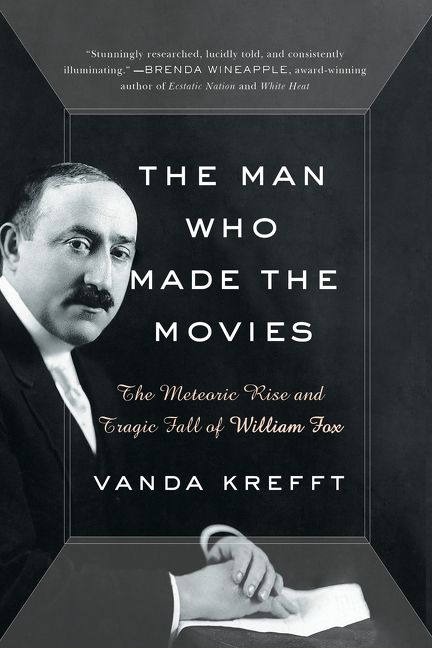


By way of an introduction to Vanda Krefft, journalist and author of The Man Who Made The Movies, tell us about your romance with the American film industry and about the decision to write this epic biography of William Fox.
 I’ve always been fascinated by the inner
workings of the motion picture industry and by history in general—so much of
the past tells us who we are today and why our culture is as it is. For years before writing the book, I worked
as freelance journalist in Los Angeles, mainly covering the entertainment
industry for national women’s magazines. During the course of that work, I met
the late Angela Fox Dunn, a fellow journalist who was William Fox’s niece.
Angela had spent a lot of time with “Uncle Bill†and had fascinating stories
about him. For the longest time, I assumed that someone had already written William
Fox’s biography because his name was on a major Holly wood studio. Then I
decided to find out if that assumption was correct. And it wasn’t. I decided to take on the task myself. One
aspect that intrigued me was the sense of tragedy that still seemed to hang
over the family. Although Fox died in 1952, my friend Angela remained
profoundly affected by him, bound to those long-ago memories and unable to move
past them completely, even though she was otherwise a very strong, positive,
and independent person.
I’ve always been fascinated by the inner
workings of the motion picture industry and by history in general—so much of
the past tells us who we are today and why our culture is as it is. For years before writing the book, I worked
as freelance journalist in Los Angeles, mainly covering the entertainment
industry for national women’s magazines. During the course of that work, I met
the late Angela Fox Dunn, a fellow journalist who was William Fox’s niece.
Angela had spent a lot of time with “Uncle Bill†and had fascinating stories
about him. For the longest time, I assumed that someone had already written William
Fox’s biography because his name was on a major Holly wood studio. Then I
decided to find out if that assumption was correct. And it wasn’t. I decided to take on the task myself. One
aspect that intrigued me was the sense of tragedy that still seemed to hang
over the family. Although Fox died in 1952, my friend Angela remained
profoundly affected by him, bound to those long-ago memories and unable to move
past them completely, even though she was otherwise a very strong, positive,
and independent person.




The rivalry between William Fox and the inventor Thomas Edison birthed what became known as the golden age of movies in America.
Share some of the most exciting facts about their rivalry.
.png) When
Fox started out in motion pictures in 1904 as the owner of a small movie
theater in Brooklyn, Thomas Edison was taking steps to monopolize the motion
picture industry through his patents. Edison claimed that he had invented the
movie camera and projector (a disputable claim, given much important prior work
by others) and thus was entitled to control the new the industry’s development
and profits. This led to the formation in 1908 of the Motion Picture Patents
Company, which allowed only ten licensed production companies to make movies in
the U.S. Soon, the Patents Company tried to monopolize movie distribution as
well. There it ran into the formidable figure of William Fox, who by now was a
movie distributor as well as an exhibitor. Rather than sell his small New York based
company, Fox instigated a Justice Department antitrust lawsuit that ultimately
dismantled the Patents Company and laid the foundation for the Hollywood studio
system. It was an astonishingly courageous move by Fox. The Patents Company
tried everything to drive him out of business, but he refused to give up and
spent a lot of time and money over a period of several years to help the
government’s lawsuit. He did so because he loved the movies and wanted to see
them prosper—and he believed that creativity could thrive only amid unfettered
competition.
When
Fox started out in motion pictures in 1904 as the owner of a small movie
theater in Brooklyn, Thomas Edison was taking steps to monopolize the motion
picture industry through his patents. Edison claimed that he had invented the
movie camera and projector (a disputable claim, given much important prior work
by others) and thus was entitled to control the new the industry’s development
and profits. This led to the formation in 1908 of the Motion Picture Patents
Company, which allowed only ten licensed production companies to make movies in
the U.S. Soon, the Patents Company tried to monopolize movie distribution as
well. There it ran into the formidable figure of William Fox, who by now was a
movie distributor as well as an exhibitor. Rather than sell his small New York based
company, Fox instigated a Justice Department antitrust lawsuit that ultimately
dismantled the Patents Company and laid the foundation for the Hollywood studio
system. It was an astonishingly courageous move by Fox. The Patents Company
tried everything to drive him out of business, but he refused to give up and
spent a lot of time and money over a period of several years to help the
government’s lawsuit. He did so because he loved the movies and wanted to see
them prosper—and he believed that creativity could thrive only amid unfettered
competition.

In the early days of Fox’s ascent to power, cinema was associated with the poor and degenerate populations of America.
How did he help change public perception of movie going from nefarious to a recreational activity fit for the country’s cultural elites?
That’s very true. In their early years in the U.S., movies were considered—at best—cheap and disposable entertainment for uneducated, lower class immigrants and—at worst—schools for crime for impressionable youth. New York newspapers and social reformers often screamed hysterically that movie theaters were the place where boys learned to steal and girls were set on the road to ruin (because they were often escorted into a dark auditorium by an older male stranger who had bought their ticket). William Fox always believed that the movies could appeal to audiences all the way up the social scale and that they represented a major new art form. To help movies get where they were going as quickly as possible, he made sure that all his early small theaters were clean, nicely decorated, and—importantly—welcoming to families. Then, around 1908, he began building some of the first movie palaces in New York City, large and lavishly decorated venues that rivaled the splendor of millionaires’ homes. He built these theaters before there was much demand for them: he was that certain, correctly, of his vision for the future.

He played a significant role in shifting the geographic nexus of movie making to the city of Los Angeles in California.
Tell us a little about Hollywood as the geographic heart of the American film industry.
Fox wasn’t the first to transplant his movie studio to Southern California from the New York metropolitan area, where the U.S. industry had started, and he was not particularly happy to do so. Money was the lifeblood of the business and financial power was centered in New York, so that was where Fox always kept his home and Fox Film’s headquarters. However, he recognized that everyone else was going west—for the weather, the variety of scenery, and to elude harassment by the Patents Company—so in the mid-1910s, he set up a major studio in the heart of Hollywood at Western Avenue and Sunset Boulevard. Then, in the mid-1920s, he bought the land that remains the site of the current studio, now called Twentieth Century Fox. It’s an astonishing property, adjacent to Beverly Hills and surrounded by very expensive residential neighborhoods. When Fox bought the land, it was a bean field. He sensed that the area was about to increase in value exponentially, and he preferred to pay a bit more rather than go to outlying or more industrial areas of Los Angeles, where other studios were located. Then, in the late 1920s, Fox built his “Movietone City†here, with beautifully designed buildings, carefully manicured grounds, and state-of-the-art sounds stages to usher in the era of talking pictures. Fox Film quickly became known as the best looking studio in Hollywood.

Your chronicle of the big studio takeovers and mergers in Hollywood, makes for fascinating reading.
Share some of the landmark features of the pivotal takeover by William Fox of Marcus Loew’s MGM.
In early 1929, Fox bought a controlling interest in Loew’s Inc., which was the parent company not only of M-G-M but also of the prestigious Loew’s theater chain. This was a major turning point in his life and was hailed as the biggest deal in motion picture history. Fox thought the acquisition was going to catapult him to the top of the worldwide motion picture industry. It did, briefly—but then, swiftly, it became the start of his downfall.
In researching this takeover, I first
had to learn what it means to buy a publicly traded company. As it turns out,
one doesn’t buy the physical assets—the real estate, the buildings, the tables
and chairs and pictures on the wall—one buys a large block of stock, which
confers control of the company. That’s what William Fox did, for $50 million,
and to make the purchase secretly (which was not illegal then), he borrowed $27
million for one year. In early 1929, with the stock market roaring ahead, that didn’t
look like a problem. Of course, everything changed in October 1929 when the
stock market crashed, creating chaos in the U.S. economy. Fox’s two creditors
decided they didn’t want their money back. Instead, they wanted control of the
robustly profitable Fox Film and Fox Theatres. Backed by Wall Street
financiers, they pushed Fox into a corner, threatened to destroy his companies,
and wrested control from him in April 1930. It was a devastating loss for Fox,
who had devoted twenty-five years of his life to building these companies. Suddenly
he was exiled from the industry he loved, with no means to fulfill his
remaining ambitions. He still had a great deal of money, but that was no
compensation. He had lost his purpose in life. Psychologically, he went off the
rails.

From silent movies to sound-on-film technology. In what other ways did William Fox influence the improvement of film production quality and viewing experience?

At his studios, Fox nurtured actors and directors who went on to become big Hollywood stars. Their legends - until your biography - outlived his own.
Name and very briefly profile some of the personalities who became and continue to be household names.
.png) Fox’s
Fox’s .png) biggest star was “vamp†Theda
Bara, the screen’s first brand name sex symbol. Her enduring fame is
remarkable—testimony to the power of her studio-created image—because of her
forty movies for Fox Film released between 1915 and 1920, only two are known to
remain. And those aren’t even her most spectacular work. Among film scholars and
fans alike, Theda’s Cleopatra (1917) ranks
as one of Hollywood’s most wanted lost films.
biggest star was “vamp†Theda
Bara, the screen’s first brand name sex symbol. Her enduring fame is
remarkable—testimony to the power of her studio-created image—because of her
forty movies for Fox Film released between 1915 and 1920, only two are known to
remain. And those aren’t even her most spectacular work. Among film scholars and
fans alike, Theda’s Cleopatra (1917) ranks
as one of Hollywood’s most wanted lost films.
Cowboy actor Tom Mix was another iconic Fox Film star during the silent era. Mix came to the studio down on his luck in the mid-1910s and was about to be dismissed by a lesser executive when he caught William Fox’s eye. Fox gave him another chance and Mix proved an instant success with his low-budget, high-action westerns, which consistently made so much money that many theater owners called him “the rent man.â€
Especially among directors, William Fox had a keen eye. He gave the great John Ford his first big break with the railroad epic The Iron Horse (1924), and gave important career-boosting assignments to Raoul Walsh, Howard Hawks, and Frank Borzage. Fox also brought German director F. W. Murnau to the U.S. to make his first Hollywood movie, Sunrise (1927), which today is considered one of the best movies of all time.

William Fox is known to have exhibited what has been termed ‘boilerplate racism’ in his films. As an African and as a promoter of African arts, I am particularly interested in that aspect of his work.
Shed light on Fox’s attitude towards race as expressed in specific films.
.png) Racism was a very difficult issue for
Fox. On the one hand, he professed to be broad-minded and inclusive in hiring,
and as a Jew in a time of rampant anti-Semitism, he well understood the
personal and social damage caused by ethnic prejudice. On the other hand, he
was fiercely ambitious in an unstable, unpredictable, and very expensive
industry where any divergence from prevailing public opinion could quickly lead
to ruin. Usually the latter frame of mind won out. A few examples: In The Nigger (1915), which was based on an
acclaimed play of the same name, a white politician cancels his engagement to
the woman he loves after being told that he has a tainted mixed race heritage.
In The Liar (1918), a mother-to-be is
terrified by visions that her child will be born black. Yet, Fox’s social
conscience wasn’t completely in eclipse. Hearts
in Dixie (1929) was—for its time—an unusual attempt to use the movies to
try to improve race relations.
Racism was a very difficult issue for
Fox. On the one hand, he professed to be broad-minded and inclusive in hiring,
and as a Jew in a time of rampant anti-Semitism, he well understood the
personal and social damage caused by ethnic prejudice. On the other hand, he
was fiercely ambitious in an unstable, unpredictable, and very expensive
industry where any divergence from prevailing public opinion could quickly lead
to ruin. Usually the latter frame of mind won out. A few examples: In The Nigger (1915), which was based on an
acclaimed play of the same name, a white politician cancels his engagement to
the woman he loves after being told that he has a tainted mixed race heritage.
In The Liar (1918), a mother-to-be is
terrified by visions that her child will be born black. Yet, Fox’s social
conscience wasn’t completely in eclipse. Hearts
in Dixie (1929) was—for its time—an unusual attempt to use the movies to
try to improve race relations.
The first almost all-black talking picture (the movie had one white character, a sympathetic doctor) released by a major studio, Hearts in Dixie had as its main character dignified African American farmer, Nappus, played by stage actor Clarence Muse, whose daughter dies at the hands of a voodoo woman. In order to ensure a better future for his beloved young grandson, Nappus sells his farm and sends the boy north for an education. The subtly subversive message is that education is the way out of oppression and that while enlightened whites (such as the doctor) may help, the downtrodden themselves have it within their power to seize control of their destiny. It was remarkable that William Fox—who never stopped worrying about money—chose to make Hearts in Dixie because Southern theaters were legally required to be segregated, and it was unlikely that white audiences there would be eager to see such a movie. Those were the movie’s positive aspects. Pandering to the status quo, various scenes showed black laborers happily picking cotton and singing and dancing while Stepin Fetchit provided “comedy†as Nappus’s lazy, sneaky son-in-law. However, such denigrating stereotypes are probably best understood as a reflection of Fox’s financial pragmatism, a willingness to do as much good as it was possible to do—and some good was better than none—without serious self-injury.

The Wall Street Journal describes the man who emerges from your book as a man with ‘a frightening level of expedience and aggression, with a touch of megalomania’.
As you researched him and pieced him together, how did you respond? In the same way?
I don’t see William Fox’s expedience and
aggression as “frightening,†except perhaps as they measure what it takes to
achieve something great in an often-ruthless capitalist society. And I am not
sure megalomania is exactly the right term for the driving force of his
ambition. Fox didn’t have didn’t have delusions of personal grandeur or much egotistical
conceit. True, he did want to rule the motion picture industry—but it’s also
true that over the years he had demonstrated remarkably clear long-term vision
and, for the benefit of the whole industry, he had fought battles that no one
else was willing to fight. I think Fox wanted to rule the industry not for
self-glorification, but because he believed he had earned the position and
would continue to earn it.

The Washington Post review refers to William Fox as becoming a mere ‘footnote in mainstream cinema history’. This is a man who was once the ‘unquestioned czar of Hollywood’.
In broad terms tell us how William Fox slipped out of public consciousness.
 In late 1929, following the stock market
crash, Fox found himself squeezed for money to pay back two large loans and
thus he was targeted by a Wall Street coalition that wanted to take over the
robustly profitable Fox Film and Fox Theatres. Fox lost the battle in April
1930 and was replaced by a series of crooked and/or incompetent executives who
promptly drove both companies into the ground. As I see it, Fox’s successors
had to erase him from history as much as possible. Otherwise the question would
inevitably have arisen: why did they get rid of a brilliant leader, under whose
guidance the companies had always made money and who had delivered many vitally
important innovations? Another reason that Fox disappeared from public view was
that he was very proud, and if people didn’t want to remember him for his
accomplishments, then he was not going to beg them to do so. He tried to draw
attention to his story by hiring Upton Sinclair to write a book, which was
published in 1933 and drew scant attention. Then Fox bribed a federal judge and
was sent to federal prison, so now the studio had even more incentive to try to
forget him.
In late 1929, following the stock market
crash, Fox found himself squeezed for money to pay back two large loans and
thus he was targeted by a Wall Street coalition that wanted to take over the
robustly profitable Fox Film and Fox Theatres. Fox lost the battle in April
1930 and was replaced by a series of crooked and/or incompetent executives who
promptly drove both companies into the ground. As I see it, Fox’s successors
had to erase him from history as much as possible. Otherwise the question would
inevitably have arisen: why did they get rid of a brilliant leader, under whose
guidance the companies had always made money and who had delivered many vitally
important innovations? Another reason that Fox disappeared from public view was
that he was very proud, and if people didn’t want to remember him for his
accomplishments, then he was not going to beg them to do so. He tried to draw
attention to his story by hiring Upton Sinclair to write a book, which was
published in 1933 and drew scant attention. Then Fox bribed a federal judge and
was sent to federal prison, so now the studio had even more incentive to try to
forget him.

How big did his empire actually become and what remains of it today?
In 1929, the Fox motion picture empire—comprising Fox Film, Fox Theatres, and the Loew’s Inc. acquisition—ranked first in the industry worldwide and had an estimated value of $300 million. Today, Fox Film has become Twentieth Century Fox (the Loew’s acquisition fell through, after opposition by the U.S. Department of Justice), and remains in West Los Angeles on the prime real estate that William Fox bought in 1923. Fox Theatres, sadly, went bankrupt in 1932 thanks to the egregious mismanagement of the bankers who pushed Fox out. The Fox lot still has many buildings from the William Fox era, so one can see many reminders of the past. The future is uncertain, though, because Disney is poised to take over the studio, assuming it can avoid antitrust charges by the Justice Department.

Finally, having engaged with a man of William Fox’s stature, one who lived at a watershed period in American political and cultural history, have you been able to identify a worthy successor for your biographer’s pen?
Excellent question! I wish I had an answer. It’s very difficult to find someone of comparable historical and cultural significance who hasn’t already been written about. William Fox was a lucky find—everyone knows the name from the studio, but no knew anything about the person behind the name. As one reviewer put it, Fox was hiding in plain sight. I’d love to find another biography subject with a compelling, important story, perhaps a woman this time.

UPDATE
In this article Vanda Krefft speaks about this development.




I am drawn to people of mixed-cultural descent and of mixed-race heritage. I'm also drawn to ...
David Aguilar, born in Andorra, is an inspiring figure known for his resilience and crea ...